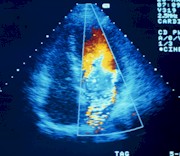Like standard echocardiography, transesophageal echocardiography (TEE) uses sound waves to produce an image of the heart and to see how it is functioning. But unlike standard echocardiography, the sound waves travel through a tube-like device put in the mouth and passed down the throat into the esophagus. (The esophagus is the tube that connects the throat to the stomach).
This test can show doctors the detailed size, shape, and movement of your heart muscle, and the condition of your aorta, which is the main blood vessel supplying blood to your body. It can also show how the heart valves are working and how blood is flowing through your heart. TEE also gives doctors information about your arteries. Doctors use this test when they cannot get a clear picture of your heart using standard echocardiography.
How does it work?
TEE uses high-frequency sound waves (also called ultrasound) that can provide a moving picture of your heart. The test is like standard echocardiography except that the pictures of the heart come from inside the esophagus rather than through the chest wall. The sound waves are sent through the body with a device called a transducer, which is attached to a tube and put down your esophagus. The sound waves bounce off of the heart and return to the transducer as echoes. The echoes are converted into images on a television monitor to produce a picture of your heart and aorta.
What should I expect?
You will need to stop eating for at least 4 hours before the test. Your doctor will tell you exactly how long. Talk to your doctor about any medicines (prescription, over-the-counter, or supplements) that you are taking because he or she may want you to stop taking them before the test.
The test will begin with the technician spraying your throat with an anesthetic, which will make it feel numb. Then, you will lie down on the examination table. A needle with a tube connected to it will be put in your arm. This is called an intravenous line or IV. The IV will give you a mild sedative to relax you throughout the test. Small metal disks called electrodes will be placed on your chest. These electrodes have wires called leads, which hook up to an electrocardiogram machine. This machine will monitor your heart rhythm during the test.
Then, a small flexible tube called a probe will be put down your throat. The technician will ask you to swallow, and the probe will be gently moved down your throat. This is often the most uncomfortable part of the test. If you feel the need to gag, do not worry, this is quite common. Once the probe is in place, you should not feel any pain.
On the end of the probe is the transducer, which takes pictures of your heart. The technician can also move the probe to get pictures of your heart from different angles.
After the technician has enough pictures, the probe and IV line will be removed. You will also be disconnected from the electrocardiogram machine. You may feel a little sleepy until the sedative has worn off, and you will be watched to see that your heart rate and blood pressure are normal.
You may find that you have a sore throat or trouble swallowing after the procedure. These side effects usually go away after a day or so.
See on other sites:
National
Heart, Lung, and Blood Institute
www.nhlbi.nih.gov/health/health-topics/topics/tee/
What is
Transesophageal Echocardiography?
Updated August 2016



